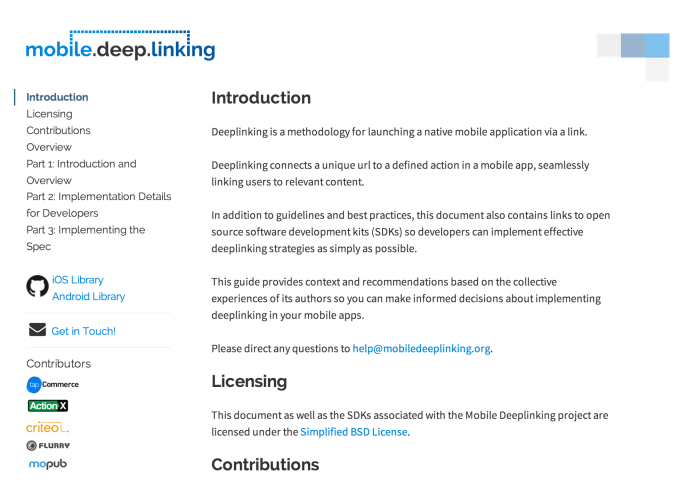A new specification for mobile deep linking – a technology that lets apps work more like the web by supporting links that can move users from app to app – is being introduced today, along with a series of best practices. The project, called MobileDeeplinking.org, has the support of several well-known mobile technology companies, including Criteo, TapCommerce, and ActionX, as well as contributions from Flurry and MoPub.
This is not the first time a mobile technology company has introduced developer-facing tools for mobile deep linking, however. Previous efforts from Quixey and deep linking service Deeplink.me been on the market since last year, while Tapstream’s “deferred deep links” only just launched, to name a few. Several developers have already implemented deep linking using these tools – for example, Deeplink.me said earlier this month adoption of its service is in the “single thousands.”
Asked why the group felt the need to introduce another open specification, TapCommerce co-founder and CEO Brian Long explained that, this time around, it’s not about just offering a set of openly accessible tools, but an open source initiative backed by a consortium of leading companies.
“Other solutions are only supported by an individual very small startup, and thus have not been widely used,” he says. “With our solution, major brands will feel comfortable implementing a solution supported by several public companies and industry leaders.”
In some of the other offerings, Long notes also that proprietary code has to be integrated for the deep linking to work, and sometimes this even includes routing URLs hosted by the company.
This is true to a point – not all the solutions have required this, but have instead offered routing URLs as an option, such as in the case of Quixey, which actually recommended developers host their own JavaScript redirect on their own website, as that would allow them to use the AppURL scheme without having to use Quixey’s appURL.org/go at all.
But still, the smattering of different solutions was confusing to developers. Because there’s no one specification that’s being widely endorsed by mobile’s top players, some app makers may have been hesitant to adopt the technology.

The other benefits to having multiple backers on board, as MobileDeepLinking.org does, is the increased input into how the specification should work, and the potential exposure it will receive now that it’s live. Combined, the spec’s working group includes contributors who represent integrations across hundreds of thousands of applications and billions of app downloads.
“We spent months with the heads of product for leading mobile companies, Flurry, MoPub, TapCommerce, and Criteo, working together to create a specification that provides a rich set of features that are easy to implement and open for either further refinement as the industry develops,” says Long.
With MobileDeepLinking.org, developers can implement deeplinking in their app using open source code, and will always be in control of the experience, while also having access to advanced features across iOS and Android for error handling, marketing automation, and advanced analytics.
The implementation process offers several different setup options, including both with and without libraries. The libraries, if developers choose to use them, are available on Github.
This particular spec, though only being introduced today, immediately has wider industry support, as all the companies involved will recommend it as the standard for all their applications and partners going forward. That leaves the question as to what will happen to the specs others have introduced so far? In time, we’ll know whether they choose to maintain their alternative solutions, or drop them in favor of joining a larger team.
However, it’s worth pointing out that, though open source, MobileDeepLinking.org is not an industry “standard” in the truest sense of the word – that is, it’s not the mobile app equivalent of something like the web’s HTTP protocol, for example. And that means many competitors may still choose to forge their own path, to try to attract their own customers.
More info about the new spec is available on the MobileDeepLinking.org domain.
